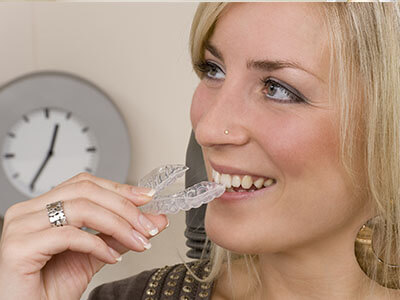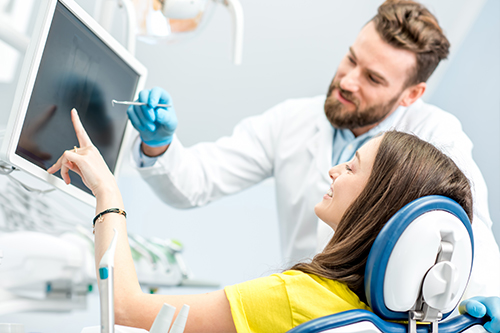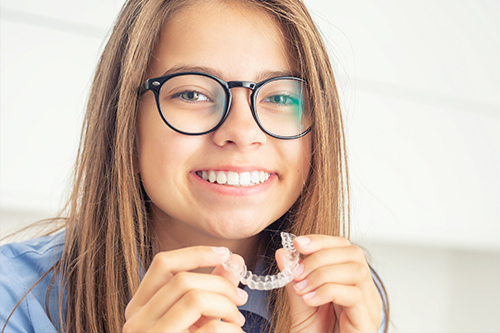Clear aligner therapy has evolved into a reliable, discreet alternative to traditional braces, blending clinical predictability with everyday convenience. At Wonderful Smiles Dental, we guide patients through the science and practicalities of Invisalign® so they can decide whether clear aligners fit their goals and lifestyle. This page explains how the system works, what to expect from treatment, and how we support lasting results.
Precision Planning: How Aligners Gently Guide Teeth
Clear aligners move teeth through a carefully staged sequence of small, controlled adjustments. Instead of wires and brackets, patients wear a series of custom-made, nearly invisible trays that apply targeted pressure to specific teeth. Each aligner is slightly different from the last, and the cumulative effect produces gradual alignment toward the planned outcome.
Treatment starts with a detailed clinical evaluation and a digital record of your mouth. Those records are used to design a step-by-step plan that maps every tooth movement from start to finish. The ability to visualize the entire course of treatment up front is a major advantage of modern aligner systems, helping clinicians set realistic expectations and identify potential challenges early.
Because the trays are removable, patients can continue normal eating habits and oral hygiene routines while undergoing treatment. Consistent wear — typically recommended for most of the day — is the single most important factor in achieving predictable progress, and we emphasize realistic daily habits to help patients stay on track.
Personalized treatment plans combine advanced imaging with clinical expertise to create clear aligners tailored to your smile.
What Happens Behind the Scenes: Digital Design and Materials
Modern aligner therapy depends on a digital workflow that converts intraoral scans into a virtual model of your mouth. Sophisticated software simulates each incremental tooth movement and helps the clinician refine the sequence for efficiency and safety. This data-driven approach reduces guesswork and improves the predictability of everyday results.
Aligner materials and the design of auxiliaries — such as attachments or precision cuts — are continually refined by research and clinical feedback. Those developments improve how force is delivered to teeth, enhance patient comfort, and expand the range of movements aligners can reliably achieve.
Clinicians use these tools to decide if aligner therapy is appropriate for each case and to tailor the plan around your anatomy and dental history. Clear aligners can address many alignment issues, but the final treatment blueprint always reflects a combination of technology and professional judgment.
- Stepwise digital planning gives clinicians a clear roadmap for treatment
- Material science and attachment strategies improve control and comfort
- Clinical assessment ensures the plan fits each patient’s oral health context
Preparing for Treatment: What Your First Visit Covers
Exam, goals, and an individualized plan
Your initial consultation brings together a focused exam, a discussion of your smile priorities, and the records needed to build the treatment plan. We assess tooth positions, gum health, and any restorative work that could influence how aligners are used.
Digital scans, intraoral photos, and radiographs (when indicated) create a precise, reproducible baseline. These records enable the team to design a plan that balances aesthetic goals with functional considerations, and they make it easier to track progress throughout treatment.
We also review practical details such as recommended daily wear time, the rhythm of follow-up visits, and best practices for cleaning and handling aligners so you can begin treatment with confidence.
Modern Scanning and Visualization: Seeing the Outcome Before You Begin
High-resolution scans and 3-D previews inform every step
Intraoral scanners capture detailed three-dimensional images of your teeth in minutes, eliminating the need for many traditional impressions. These digital models feed directly into planning software, where clinicians can simulate treatment stages and preview expected results with patients.
Seeing a visual projection of potential outcomes helps patients make informed decisions and gives clinicians a basis for fine-tuning movement strategies. If adjustments are needed during treatment, the digital records make it simpler to revise the plan and communicate changes to the lab or manufacturer.
Secure storage of digital records also supports consistent monitoring. At follow-up visits, scans can be compared to the original plan to confirm progress or to guide small course corrections when required.
How Aligners Are Made and What Wear Is Like
Custom-formed trays built for fit and function
Each aligner is manufactured to match the digital prescription for a precise fit. The trays are smooth and contoured to sit snugly over the teeth, distributing gentle forces where they’re needed. Many patients find them more comfortable than traditional brackets and wires once they adapt to wearing them.
Small, discreet attachments may be bonded to select teeth to help achieve complex movements; these are typically tooth-colored and removed after active treatment. Your clinician will explain how attachments work and why they’re useful for achieving the planned outcome.
Routine check-ins let us confirm fit and progress, supply the next series of aligners, and address any questions about daily care. With attentive clinical oversight, the treatment moves steadily toward its target while keeping oral health a priority.
Finishing Strong: Retention and Long-Term Stability
Preserving your new alignment with a sensible retention plan
Once active alignment is complete, a retention phase protects the new tooth positions. Retainers — removable or fixed depending on individual needs — are custom-designed to maintain stability and prevent relapse. A well-planned retention strategy is essential to protect the investment of time and care made during treatment.
Continuing routine dental exams and excellent oral hygiene supports long-term success. Healthy gums and teeth respond more predictably to orthodontic forces and create a favorable environment for retention appliances to do their job.
We work with each patient to establish a retention schedule that fits their lifestyle and clinical needs, with periodic reviews to ensure the teeth remain stable over time.
Visual Resources and Clinical Overviews
Short, educational videos can clarify how aligner therapy works and what day-to-day life with aligners looks like.
These resources demonstrate proper insertion and removal techniques, recommended cleaning methods, and the typical cadence of appointments. They are designed to supplement the personalized guidance provided during your consultation and follow-up visits.
Remember that these materials are educational in nature; an in-person evaluation is necessary to determine the most appropriate course of care for your smile.
*Invisalign® is a registered trademark of Align Technology, Inc.
In summary, contemporary clear aligner therapy offers a predictable, patient-friendly approach to correcting many alignment concerns while allowing patients to maintain daily routines and oral hygiene. If you’d like to learn whether Invisalign® is right for you, please contact us for more information and to schedule a consultation with our team at Wonderful Smiles Dental.






